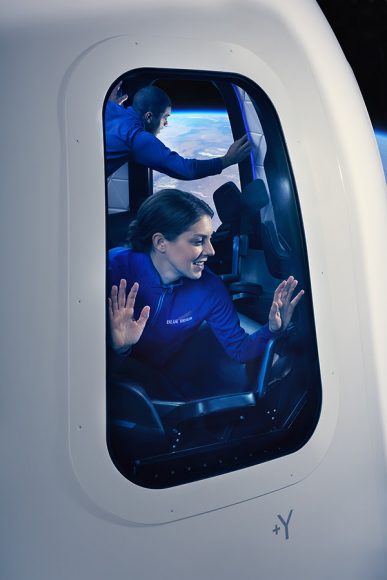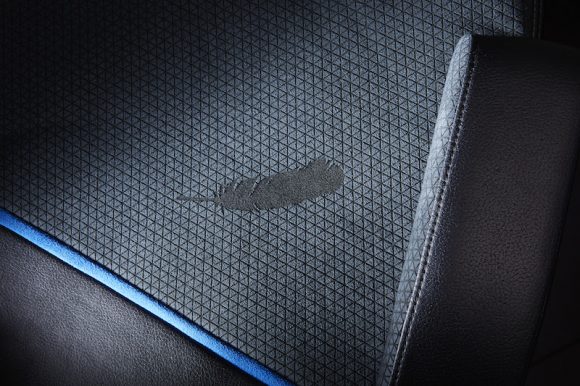Blue Origin founder Jeff Bezos provided a sneak peek today into the interior of the New Shepard crew capsule, the suborbital vehicle for space tourism. He released a few images which illustrate what the flight experience might be like on board.
"Our New Shepard flight test program is focused on demonstrating the performance and robustness of the system," Bezos said via an email release. "In parallel, we've been designing the capsule interior with an eye toward precision engineering, safety, and comfort."
Take a look:

A view of the interior of the New Shepard crew capsule from Blue Origin. Credit: Blue Origin.
The interior has six seats with large windows for a great view of our planet.
"Every seat's a window seat," Bezos said.
What looks like a console in the center of the capsule is actually the escape motor to protect future passengers from any anomaly during launch. Unlike the Apollo escape system that used an escape "tower" motor located on top of the capsule to 'pull' the crew cabin away from a failing booster, New Shepard's escape system is mounted underneath the capsule, to 'push' the capsule away from a potentially exploding booster. Blue Origin successfully tried out this escapes motor in October 2016 during an in-flight test.

Blue Origin touts the view from the New Shepard crew capsule as 'the largest windows ever in space.' Credit: Blue Origin.
Blue Origin's suborbital rocket is named after Alan Shepard, the first NASA astronaut to take a suborbital trip to space in 1961. Their orbital rocket will be named New Glenn, named for John Glenn, the first American in orbit. Blue Origin is also developing a larger rocket to bring payloads beyond Earth orbit, and they've named that vehicle after Neil Armstrong, the first human to walk on the Moon.
Blue Origin hasn't released a timeline yet of when they will be flying their first paying passengers; all Bezos has said is that he hopes to fly as soon as possible.
The commercial company describes the experience this way:
Following a thrilling launch, you'll soar over 100 km above Earth—beyond the internationally recognized edge of space. You'll help extend the legacy of space explorers who have come before you, while pioneering access to the space frontier for all.
Sitting atop a 60-foot-tall rocket in a capsule designed for six people, you'll feel the engine ignite and rumble under you as you climb through the atmosphere. Accelerating at more than 3 Gs to faster than Mach 3, you will count yourself as one of the few who have gone these speeds and crossed into space.

Blue Origin's black feather logo on the New Shepard rocket is 'a symbol of the perfection of flight,' says founder Jeff Bezos. Credit: Blue Origin.
"We are building Blue Origin to seed an enduring human presence in space, to help us move beyond this blue planet that is the origin of all we know," Bezos said in the press release after a successful test flight of the New Shepard rocket in 2015. "We are pursuing this vision patiently, step-by-step. Our fantastic team in Kent, Van Horn and Cape Canaveral is working hard not just to build space vehicles, but to bring closer the day when millions of people can live and work in space."
Blue Origin's black feather logo on the New Shepard rocket is 'a symbol of the perfection of flight,' says founder Jeff Bezos, and "flight with grace and power in its functionality and design."
Their moto, "Gradatim Ferociter" is Latin for "Step by Step, Ferociously." Bezos has said that is how they are approaching their goals in spaceflight.
Find out more about the Blue Origin "Astronaut Experience" on their website.
If you're lucky enough to be attending the 33rd Space Symposium in Colorado Springs April 3-6, 2017, you can see the New Shepard capsule for yourself. "The high-fidelity capsule mockup will be on display alongside the New Shepard reusable booster that flew to space and returned five times." Bezos said.
No comments:
Post a Comment